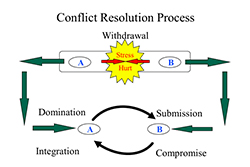
Within any environment there can and most often is, some degree of conflict. Mild or severe, because we all have our own innate likes and dislikes, there are things that cause friction within our inner self. The cause of the conflict can range from a diversity of sources: an individual, your environment, a process, etc. These are all examples of external conflict, which is easy to recognize because it is something that causes you anxiety or discomfort. It is more tangible and direct and often associated with the workplace. Internal conflict is much more difficult to identify and assess, however, it is the type of conflict that must be managed to resolve any type of conflict in your life. You may not be able to change or have influence over an external conflict, but you can determine how you manage that conflict internally, and develop a healthy attitude and inner well-being to move on. An inability to manage a conflict eliminates any chance of resolving that conflict.
Within the Histopathology lab there are numerous external factors that can evoke conflict within the technologist. Work overload from insufficient staffing is a common cause where individuals are always rushing trying to carry the load of 2-3 techs. Cramped seating and workspace making it difficult to perform effectively. Ineffective management or leadership skills from the manager or supervisor resulting in poor relationships. Personal differences with co-workers. Unnatural work schedules (as in Night Shift) where fatigue and tiredness can cause short tempers. All of these are external factors that can induce conflict.



For information about the Lab Storage Systems product line and services please contact our Customer Relations Manager or our Technical Marketing Specialist today.
References:
Newkirk, WB, Brown, S., ‘Gold Standard of Leadership – Conflict Resolution’, Workshop in Professional Development, WB Newkirk Consulting, Lab Management Consultants, 2010.

